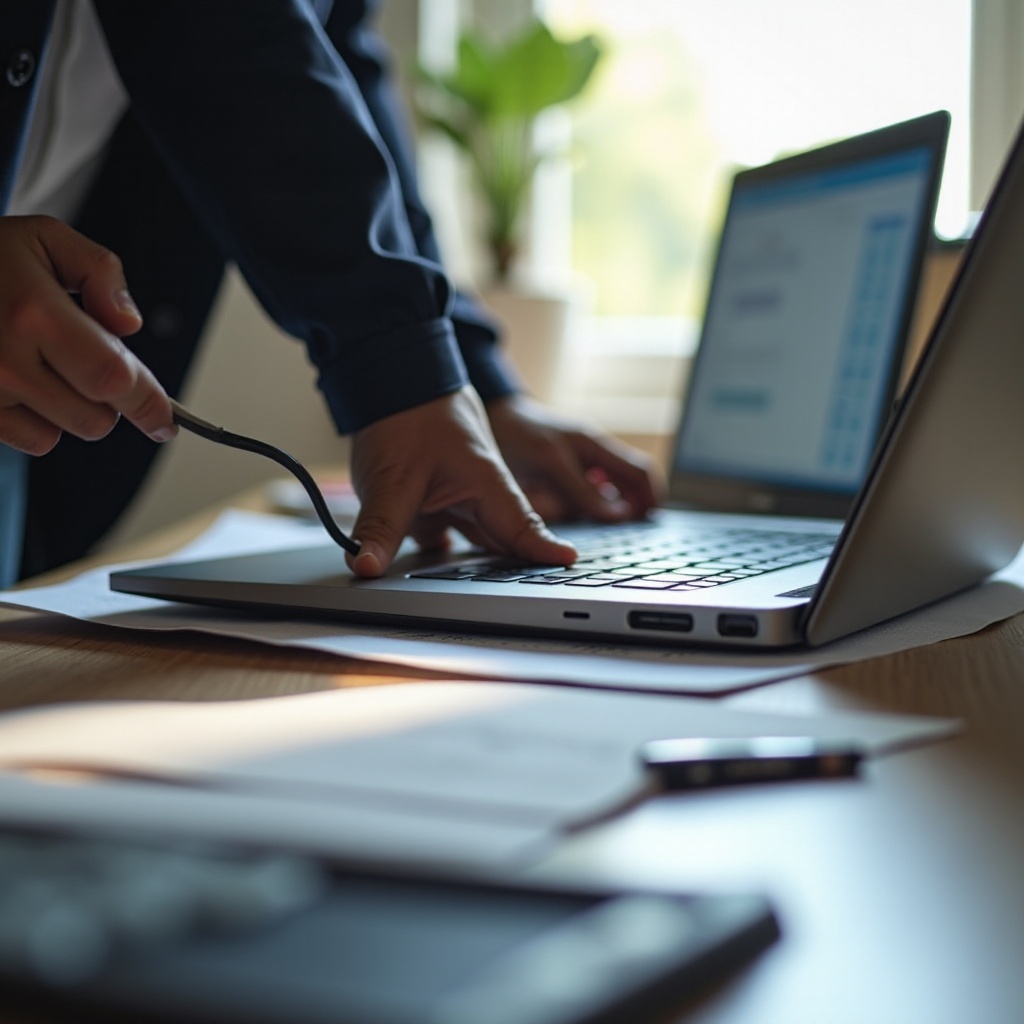Introduction
When your laptop suddenly shuts off and won't turn back on, it can cause anxiety and disrupt your work. This issue can stem from various problems, both simple and complex. This guide will walk you through the necessary steps to troubleshoot and resolve these issues efficiently.

Immediate Actions to Take
When facing a sudden shutdown, starting with basic troubleshooting can often quickly identify and resolve the problem.
Check the Power Supply
- Verify Battery Charge: Ensure your laptop battery has enough charge. If not, connect it to a power source.
- Test the Power Adapter and Cord: Check if the power adapter and cord are working properly. Try using a different power adapter if possible.
Perform a Hard Reset
Sometimes, performing a hard reset can resolve the issue by clearing residual power and resetting internal components.1. Steps for a Hard Reset:- Unplug the laptop from the power source.- Remove the battery if it is removable.- Press and hold the power button for 15-20 seconds.- Reconnect the battery and power adapter, then attempt to power on the laptop.
Inspect for Physical Damage
- Visual Checks for Hardware Issues: Examine the laptop for any signs of physical damage, including cracked or broken parts, which could prevent it from powering on.
- Assessing Damages on External and Internal Parts: Open the laptop carefully (if you feel comfortable doing so) to check for internal damage, such as loose connections or burnt components.
Advanced Troubleshooting Techniques
If the initial steps don't solve the problem, move on to more advanced troubleshooting methods.
Checking Internal Components
- RAM and Hard Drive Checks: Sometimes, reseating or replacing RAM and hard drive components can resolve power issues. Ensure they are securely connected.
- Inspecting the Motherboard: Look for signs of damage or component failure on the motherboard. Common signs include burnt spots or a strong smell of burnt plastic.
Evaluating Hardware Issues
- Checking for Overheating: Overheating can cause laptops to shut off. Clean the cooling fans and ensure adequate ventilation.
- Inspecting and Reseating RAM and Storage: Sometimes, simply reseating the RAM and storage devices can fix the issue. Remove these components, clean the contacts, and reinsert them firmly.
Identifying Software Problems
- Booting into Safe Mode: Attempt to boot the laptop into safe mode to diagnose software issues. This mode starts the computer with minimal drivers and can help identify if a software conflict is preventing the laptop from turning on.
- Running Diagnostics: Use built-in diagnostic tools to check for hardware or software issues. Many laptops have built-in diagnostics that can be accessed during the boot process (refer to your laptop's manual for specific instructions).

When to Seek Professional Help
If you've tried troubleshooting on your own and the laptop still won’t power on, it may be time to consult a professional technician.
Signs You Need a Technician
- Persistent Hardware Issues: If you notice persistent hardware issues like a damaged motherboard or burnt components, these typically require professional repair.
- Complex Software Problems: Advanced software problems, such as corrupted BIOS, usually require expert attention to fix.
Understanding Repair Costs
Knowing the potential costs of repairs can help you decide whether to proceed with fixing your current laptop or invest in a new one.1. Common Repair Costs: Basic diagnostics and minor hardware replacements can cost between $50-$150. Major repairs, like motherboard replacement, could cost $200 or more.2. Cost-Benefit Analysis: Compare the repair costs with the price of a new laptop to determine whether it's more economical to repair or replace.
Prevention Tips to Avoid Power Issues
To avoid facing similar issues in the future, take preventative measures to maintain your laptop’s health.1. Regular Maintenance: Clean the laptop's vents and fans regularly to prevent overheating and system failures.2. Use a Surge Protector: Always use a surge protector to shield your laptop from unexpected power surges.

Conclusion
By following these steps, you should be able to diagnose and fix many common issues that cause a laptop to shut off and not turn back on. Regular maintenance and being mindful of your laptop’s condition can prevent many of these problems from occurring.
Frequently Asked Questions
What can I do if my laptop power adapter is not working?
If your laptop power adapter is not working, try using a different adapter to see if it powers on the laptop. If it works with a different adapter, replace the faulty one. Additionally, check for any visible damage to the cord or connector and ensure it fits securely.
How do I know if my laptop's battery needs replacement?
If your laptop only works while plugged in, the battery drains quickly, or the charging status is inconsistent, it may be time to replace the battery. Most laptops have tools to check battery health; you can also consult a technician for a battery test.
Can overheating cause my laptop to shut off and not turn back on?
Yes, overheating can cause your laptop to power off and fail to turn back on until it cools down. Ensure that the cooling system is functioning correctly and that the vents are not blocked. Regularly clean dust from the fans and cooling vents to prevent overheating.
